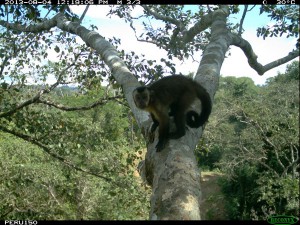By Rashidah H. Farid, M.S.
Doctoral Student, Wildlife Ecology and Conservation
University of Florida
Email: rfarid@ufl.edu
In Peru, the majority of the land is under some form of a hydrocarbon lease. Seventy-two percent of these leases overlap with areas of high biodiversity. For Peru, and much of the Amazon rainforest, it has become increasingly important for researchers to understand and mitigate the impacts of habitat fragmentation from hydrocarbon activities. On January, 12th 2015, researcher Dr. Tremaine Gregory, of the Smithsonian Conservation Biology Institute, presented her work in the Amazonian canopy of Peru. The four year study employed camera traps to monitor arboreal mammal use of canopy bridges across fragmented forest. Gregory’s team collaborated with a hydrocarbon company to plan the location and width of each canopy bridge as well as identified control sites before construction of a pipeline began. These bridges are natural canopy overhangs, joining the terrestrially fragmented habitat above the pipeline.
The research team climbed over 20 meters in the air to position the cameras on natural canopy bridges. Ground cameras were also installed to determine if the canopy bridges above had an effect on terrestrial crossings below. The presence of the team before, during and after construction, permitted them to measure impacts of pipeline construction in multiple ways. They monitored primate groups’ distance from pipeline by species, and crossing rates by bridge and on the ground. The camera traps captured images over six months and included 22 mammal species. Arboreal mammals were found to use the canopy bridges often and infrequently crossed bare ground. There was also variation in canopy bridge use depending on width of crossing. For example, the canopy bridges mostly frequently used were also the narrowest in width. These results add gravity to the growing advocacy for natural canopy bridges as a means to reduce the fragmentation of home ranges and increase connectivity between different life stage habitats.
Gregory’s team’s novel use of an old, inexpensive and noninvasive technology has opened the possibilities of future canopy research. To find out more about Dr. Tremaine Gregory and her research on can opy bridges, visit: http://smithsonianscience.org/2013/10/natural-canopy-bridges-maintain-connections-in-the-forest/.



 0
0
